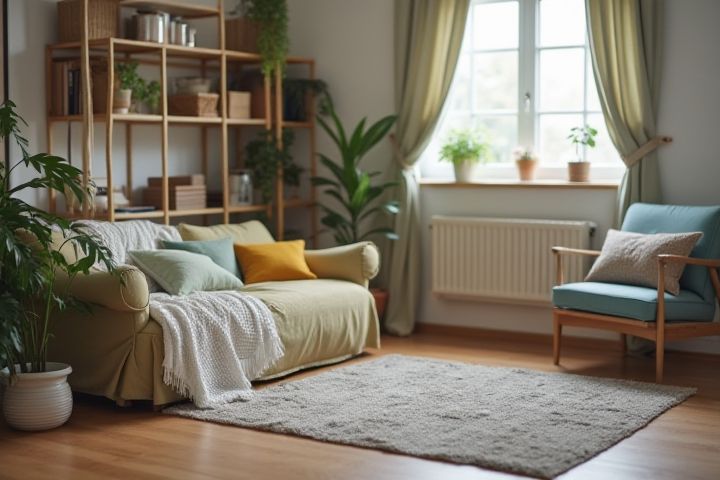
To declutter your house efficiently, start by sorting items into categories such as keep, donate, and discard. Focus on one room or area at a time to avoid feeling overwhelmed, and set a timer to maintain a steady pace. Utilize storage solutions like bins and shelves to organize the items you choose to keep, ensuring everything has a designated space. Consider adopting a "one in, one out" rule, which helps maintain clutter-free spaces in the future. Regularly reassess your belongings every few months to prevent accumulation and promote a more minimalist lifestyle.
How To Declutter A House Efficiently
Set clear goals
Set clear goals by first identifying specific areas of your home that need decluttering, such as your living room, kitchen, or bedrooms. Create a timeline for each space; for instance, aim to tackle one room per week to make the process manageable. Determine criteria for what to keep, donate, or discard, ensuring that every item serves a purpose or brings you joy. By establishing these focused objectives, you can streamline your decluttering efforts, making the task more efficient while transforming your home into a more organized space.
Start small
To efficiently declutter your house, begin with small, manageable areas, such as a single drawer or a corner of a room. This can prevent feeling overwhelmed and make progress more visible; for example, decluttering just one kitchen drawer can take as little as 15 minutes. Aim to remove 10-20% of items in that space, evaluating each piece for its necessity and sentimental value. As you make headway, your sense of accomplishment will motivate you to tackle larger areas, creating a more organized living environment.
Use a sorting system
A sorting system is an effective way to declutter your house efficiently, enabling you to categorize items into specific groups. Consider using four primary categories: keep, donate, sell, and discard, assigning each item to one of these groups based on its condition and your needs. You can set a time limit, such as 30 minutes, to make quick decisions, preventing overthinking and encouraging a more decisive approach. By systematically addressing one room at a time, you can significantly reduce clutter and streamline the decluttering process.
Follow the "one in, one out" rule
Implementing the "one in, one out" rule is an effective strategy for decluttering your home. Whenever you acquire a new item, make a conscious decision to remove an existing item from your space, ensuring that your possessions remain balanced. This method not only helps maintain order but also encourages mindfulness about your purchases, fostering a more intentional lifestyle. You'll find that over time, this practice minimizes clutter, making your living environment more organized and manageable.
Categorize items
Begin your decluttering process by categorizing items into groups such as clothing, books, electronics, kitchenware, and sentimental items. This approach allows you to visualize the volume of possessions you have and identify duplicates or items you rarely use. As you sort through each category, consider creating subcategories for donations, recycling, or items needing repair, ensuring that every piece has a purpose in your decluttering journey. By systematically organizing your belongings, you can create a more functional and inviting living space that aligns with your lifestyle.
Use labeled storage
Using labeled storage is a highly effective method for decluttering your home. Assign clear, descriptive labels to each container or box, enabling you to quickly identify the contents without opening them. This organized approach not only helps you locate items easily but also encourages consistent maintenance, reducing clutter over time. For optimal efficiency, consider categorizing items by usage frequency or type, allowing you to streamline access to your belongings.
Allocate dedicated time
To declutter your house efficiently, allocate dedicated time blocks specifically for this task. Aim for 30 to 60 minutes per session, allowing you to maintain focus and momentum without feeling overwhelmed. Create a schedule that breaks down areas of your home, assigning specific days for each room or space, ensuring every part of your house receives attention. Using this method not only maximizes productivity but also transforms the decluttering process into a manageable and less daunting experience.
Minimize emotional attachment
To efficiently declutter your house, begin by recognizing the emotional attachment that often hinders the process. Set a timeline, aiming to tackle one room or area each week, which creates urgency and reduces the temptation to hold onto items. Use the "Keep, Donate, or Discard" method, allowing you to categorize belongings without second-guessing your decisions. Remember, a home with less clutter can improve your mental clarity and overall well-being, making the effort worthwhile.
Donate or sell unused items
To efficiently declutter your house, start by identifying unused items that can be donated or sold. Focus on categories like clothing, furniture, and electronics, as these often accumulate without regular use. Utilize online platforms such as Facebook Marketplace or local buy/sell groups to reach potential buyers, while scheduling donation pickups with charities like Goodwill or Habitat for Humanity to streamline the process. Set a timeline for your decluttering project to maintain focus and ensure that your living space remains organized and inviting.
Create a decluttering routine
Creating a decluttering routine can transform your home into a more organized space. Start by designating a specific time each week, ideally 30 minutes to 1 hour, to focus solely on decluttering. Use the "one in, one out" rule to manage items; for every new item brought in, an old item should be removed. Finally, tackle one room or area at a time, breaking the task down into manageable sections to prevent feeling overwhelmed.
